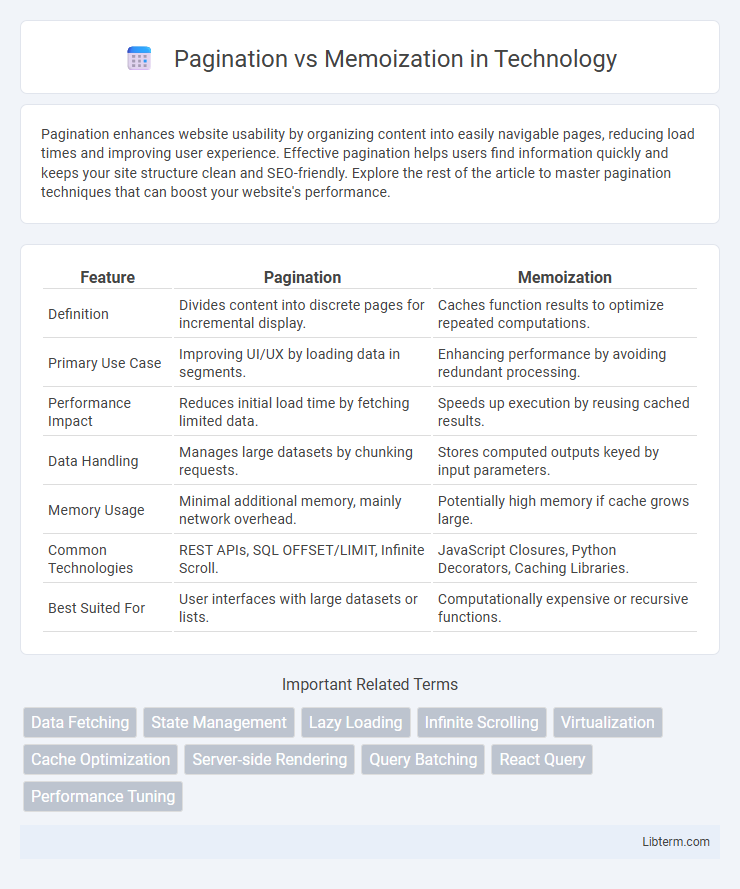Pagination enhances website usability by organizing content into easily navigable pages, reducing load times and improving user experience. Effective pagination helps users find information quickly and keeps your site structure clean and SEO-friendly. Explore the rest of the article to master pagination techniques that can boost your website's performance.
Table of Comparison
| Feature | Pagination | Memoization |
|---|---|---|
| Definition | Divides content into discrete pages for incremental display. | Caches function results to optimize repeated computations. |
| Primary Use Case | Improving UI/UX by loading data in segments. | Enhancing performance by avoiding redundant processing. |
| Performance Impact | Reduces initial load time by fetching limited data. | Speeds up execution by reusing cached results. |
| Data Handling | Manages large datasets by chunking requests. | Stores computed outputs keyed by input parameters. |
| Memory Usage | Minimal additional memory, mainly network overhead. | Potentially high memory if cache grows large. |
| Common Technologies | REST APIs, SQL OFFSET/LIMIT, Infinite Scroll. | JavaScript Closures, Python Decorators, Caching Libraries. |
| Best Suited For | User interfaces with large datasets or lists. | Computationally expensive or recursive functions. |
Introduction to Pagination and Memoization
Pagination divides large datasets into manageable chunks, improving user experience by reducing load times and optimizing data retrieval in applications like websites and databases. Memoization stores the results of expensive function calls, enabling faster access to previously computed values and enhancing performance in complex calculations and recursive algorithms. Both techniques are essential for efficient data handling, with pagination focusing on data presentation and memoization on computational efficiency.
Defining Pagination: Concept and Use Cases
Pagination divides large datasets into smaller, manageable pages to improve data retrieval and user experience on websites and applications. It reduces server load and enhances performance by fetching only a subset of data at a time, commonly used in search engines, social media feeds, and e-commerce product listings. Pagination involves parameters like page number and page size, enabling efficient navigation through vast amounts of information.
Understanding Memoization: Definition and Applications
Memoization is a technique in computer science that stores the results of expensive function calls to optimize performance by avoiding redundant calculations. It is widely applied in dynamic programming, recursive algorithms, and caching mechanisms to improve efficiency in scenarios with overlapping subproblems. Understanding memoization facilitates faster computations in complex systems such as search engines, data processing pipelines, and machine learning model training.
Key Differences Between Pagination and Memoization
Pagination divides large datasets into manageable pages for efficient data retrieval and display, improving user experience and reducing load times. Memoization stores the results of expensive function calls to reuse them when the same inputs occur, optimizing computational performance by avoiding redundant calculations. Pagination targets data management and navigation, whereas memoization focuses on computational efficiency within algorithms.
Pros and Cons of Pagination
Pagination improves website performance by dividing content into manageable chunks, reducing load times and enhancing user experience on large data sets. However, it can disrupt continuous reading flow and requires additional backend logic for managing page states and queries. Despite these drawbacks, its scalability and efficient resource usage make pagination a preferred method for handling vast amounts of user data.
Pros and Cons of Memoization
Memoization improves performance by storing the results of expensive function calls and reusing them when the same inputs occur, significantly reducing redundant computations in recursive algorithms. However, it increases memory usage since cached results must be stored, which can lead to inefficiency in applications with large or numerous unique inputs. Memoization also adds overhead to cache management and may not provide benefits in scenarios where input data rarely repeats or memory resources are limited.
When to Use Pagination vs Memoization
Pagination is ideal for handling large datasets by loading data in chunks, improving performance and user experience when displaying lists or tables. Memoization is best suited for optimizing repeated function calls by caching results, enhancing efficiency in computational-heavy processes with deterministic outputs. Use pagination for scalable data retrieval and memoization for reducing redundant calculations in applications.
Performance Impact: Pagination vs Memoization
Pagination improves performance by reducing the amount of data loaded and rendered at once, minimizing memory usage and speeding up initial page loads. Memoization enhances performance by caching expensive function results, preventing redundant computations and decreasing processing time for repeated inputs. Combining pagination with memoization can yield optimal performance by limiting data scope while efficiently reusing computed results.
Real-World Scenarios and Examples
Pagination improves user experience by dividing extensive datasets into manageable chunks, commonly used in e-commerce platforms to display product listings without overwhelming the interface. Memoization enhances performance in applications like dynamic programming problems or recursive function calls, where previously computed results are stored to avoid redundant calculations. In real-world scenarios, combining pagination for data loading and memoization for caching computation results optimizes both data retrieval time and system responsiveness.
Conclusion: Choosing the Right Approach
Pagination offers efficient data management by loading only necessary portions, reducing memory usage and improving performance for large datasets. Memoization enhances computational efficiency by caching results to avoid redundant calculations, ideal for functions with repetitive calls and stable inputs. Selecting between pagination and memoization depends on whether the priority lies in managing data retrieval or optimizing function execution speed.
Pagination Infographic

 libterm.com
libterm.com